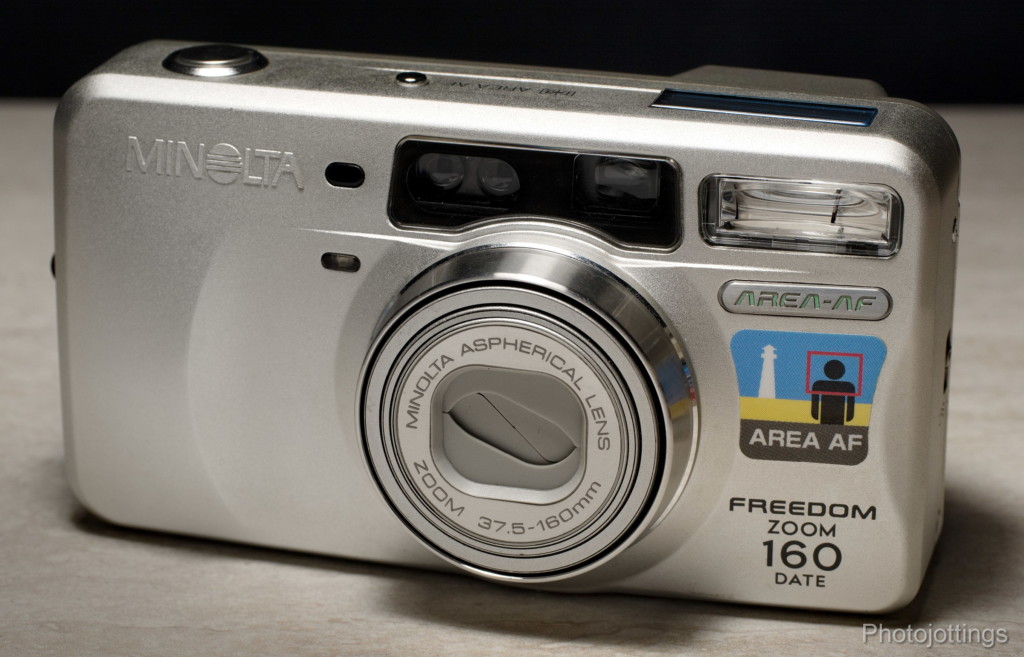
Minolta produced some really nice film cameras back in the day, and the Freedom Zoom 160 is no exception. This camera is surprisingly small and lightweight for having such a large zoom range, which makes is very pocketable, and close to being as tiny as the Olympus XA! Main features include a zoom range of 37.5-160mm, earth shattering high tech auto focus, (really, read the next paragraph!), auto loading, film advance, rewind, self timer, flash, auto parallax correction, and even a +1.5 exposure compensation setting!
The Minolta Freedom Zoom 160 came out near the end of the film camera era, (around 2001), so it had a lot of sophisticated features that we take for granted today, such as predictive AF, eyepiece sensor metering/AF activation, and flash distance integration to name a few. In fact, Minolta claimed in a 2001 business ad the camera had: the world’s largest AF area in a film camera — the world’s first film camera with subject detection — the world’s first compact camera with matrix AF indication and automatic LED brightness control — advanced subject-weighted multi-segment metering — eye start, a 32-bit RISC processor, and a high-speed AF drive creating the world’s fastest focusing compact camera in its class.
All that sounds pretty cool, but how well does the camera actually work in real life? let’s find out now!
Name; Minolta Freedom Zoom 160 Date; Called Minolta “Riva 160” in other parts of the world. Konica may have added their name and restyled the camera in later models.
Manufactured by; Minolta Co, LTD, Osaka, Japan. Made in China.
Date of manufacture; 2001-2002?
Price; initial release retail price around $249+ in 2001; probably less at large discount stores, and by mid-2002, a Photo magazine ad stated the price around $200. Current ebay prices are around $15-$25 for a good used copy. I got mine for about $5 as it was purchased in a lot of 10.
Other versions; there is a Freedom Zoom 140 with a 37.5-140mm range; and has a corresponding change in apertures etc, but no exposure compensation; everything else seems the same as the 160.
Build material; mostly metal covered body with a clear plastic window over the view finder area, LCD and film reminder slot.
Weight and size; camera with battery, 7.4oz (210g). Camera only 6.9 oz (195g).
Dimensions; Size is 4.4″ (110.5mm) wide, 2.4″ (60.5mm) high, and 2.0″ (51mm) deep including lens protrusion in off position.
Focal length; 4.3x zoom from 37.5-160mm.
Aperture; maximum aperture at 37.5mm is F/5.4; maximum at 160mm is a whopping F/12.4.
Focusing; area AF, which includes world’s largest AF area, predictive subject detection, matrix AF indication, and high-speed AF drive, has 942 focus steps. Focuses from 2.0′ (0.6m) at the wide end, to 3.1′ (0.95m) at 160mm.
Original print size; standard oversize prints 4″ x 6.″
Approximate resolution; will make excellent 5″x 7,” and good to excellent 8″x 10″ prints.
Lens; coated glass six elements in six groups design, with two double sided apherical elements. 37.5-160mm focal length, F/5.4-12.4 maximum aperture. The zoom feature has 14 stop (focal lengths) settings total.
Shutter and speed; electromagnetic shutter and aperture. Ten seconds to 1/500s.
Distortion; very straight at wide angle, and moderate barrel type at the telephoto end.
Color fringing; very minor magenta along the sides at high contrast areas.
Features; auto load, auto advance, auto rewind, flash on or off position, red-eye reduction, date imprinting on-off, goes to 12-31-2099!!, zoom lens, exposure compensation of +1.5, auto focus, auto film DX coding, tripod socket and self timer, continuous shooting, plus others.
Film; all 135 film cartridges, B&H, Amazon, eBay.
Flash. range of 2.0-15.1 feet (0.6-4.6m) at wide angle, and telephoto; 3.1-6.6 feet (0.95-2.0m) at ASA 100. has flash on-off, auto, auto red-eye reduction, fill, and slow sync night modes. Uses distance integration (they call it ‘light intensity control’), for throttling the flash power at close range. Recharges in 5-6 seconds with fresh battery.
Power; One CR123A 3v battery, lasts for about 10 rolls of 24 using the flash every other shot. Usually available at big box stores or drug stores, but super expensive. Get them much cheaper here: B&H, Amazon, eBay.
Viewfinder; small, with decent brightness, has auto illuminating parallax correction guidelines and red outlined AF areas. Eye relief 17.3mm from viewfinder frame. Magnification 0.38x-1.51x, field of view at 3m; 85%. Also has orange flash ready light/shake warning, and green focus confirmation indicator along side of frame. On the left side are eye detectors.
DX coding; from ISO 25-3200. Non DX coded film is registered as ISO 100.
Accessories for this model; Minolta remote control RC-3.
Crippling features and omissions; none, but a diopter correction for viewfinder would’ve been handy in this price range.
Good features; super fast and accurate AF, auto parallax correction, exposure compensation, and excellent metering.
Go here for the manual download, or here to view a copy, and make sure you tip the site owner!
Product shots with descriptions. Click for larger images.
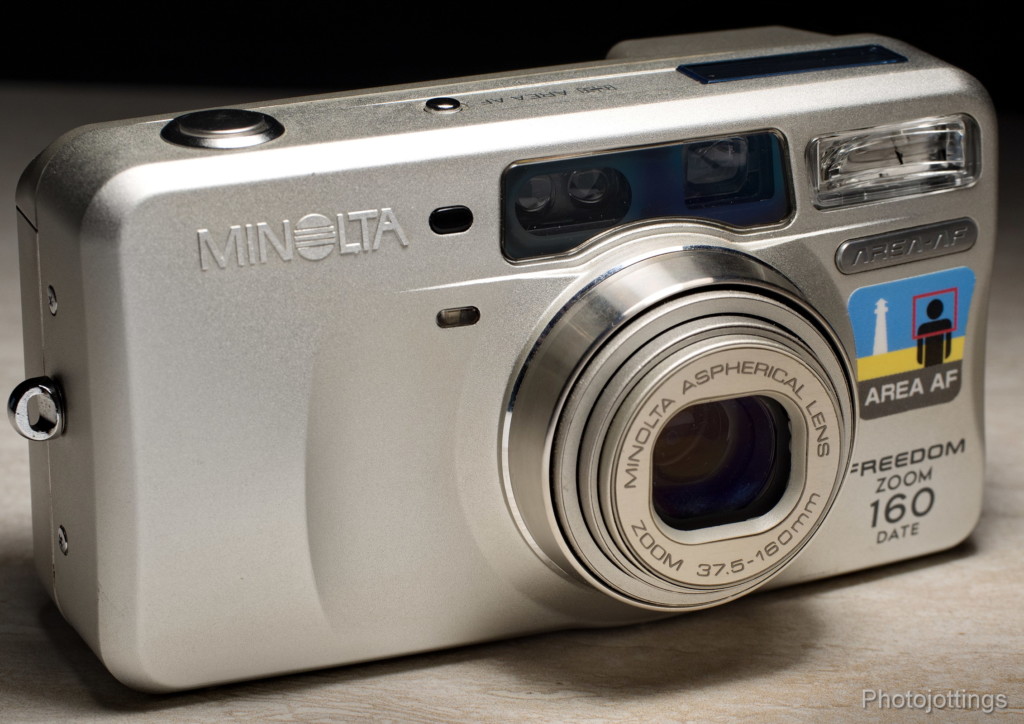
From view with the power turned on. The Area AF sticker is still on this pristine sample. From left to right; along the side is a strap lug; the two small windows are for the remote control. The large window above the lens is for the AF/metering on the left, and viewfinder on the right. The flash is at the right top corner.

The only two items on the bottom are the tripod socket and tiny mid-roll rewind button. On the left lower corner is the battery compartment.
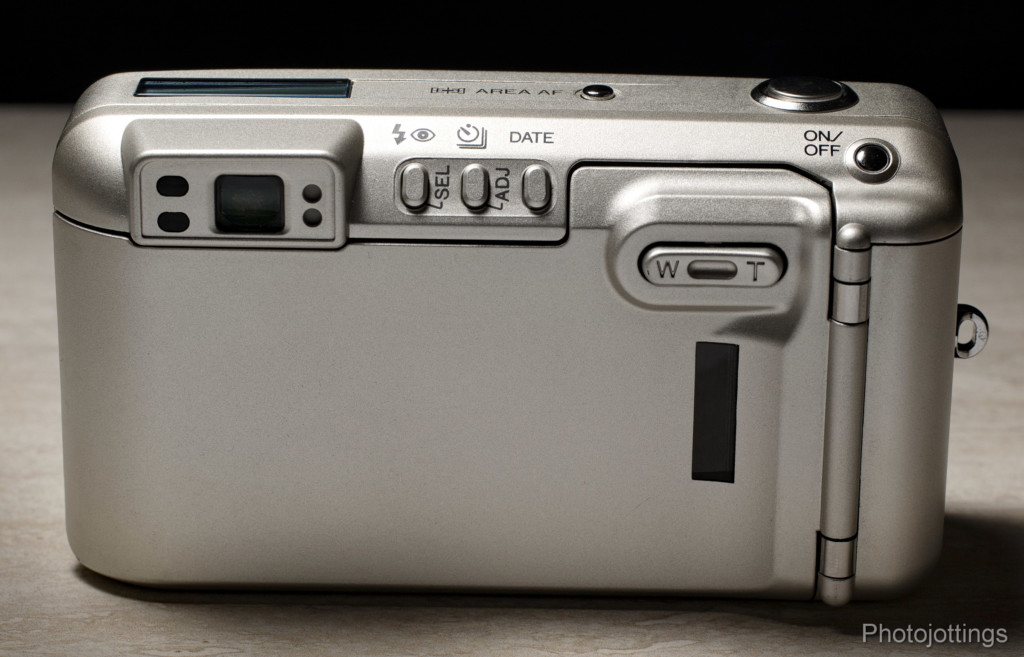
The back of the camera shows the viewfinder, which has two oblong openings on the left; those are for eye detecting and starting the AF and metering. The two circular holes on the right side are for focus and flash, the top one turns solid green when focus is locked, and flashes green when it can’t lock. The bottom indicator is for flash charging; solid orange for flash ready, and flashing orange for flash charging or shake/low shutter speed warning. The three buttons in the middle group from left to right are: flash on-off, auto, auto red-eye reduction, fill, slow sync night mode, and exposure compensation +1.5 EV. The middle button is for setting the timer, remote use, and continuous shooting (about 2 frames per second) mode. The right button is for setting the date for imprinting, either on or off. The W-T button is for zooming, and finally we have the on-off button in the upper right corner.

With the back open you can see the camera has some decent features like a real film pressure plate, a spring steel film tensioner and thick light sealing foam around the film reminder window, but none along the perimeter of the back cover. Nice multi coatings visible on the lens and viewfinder glass.
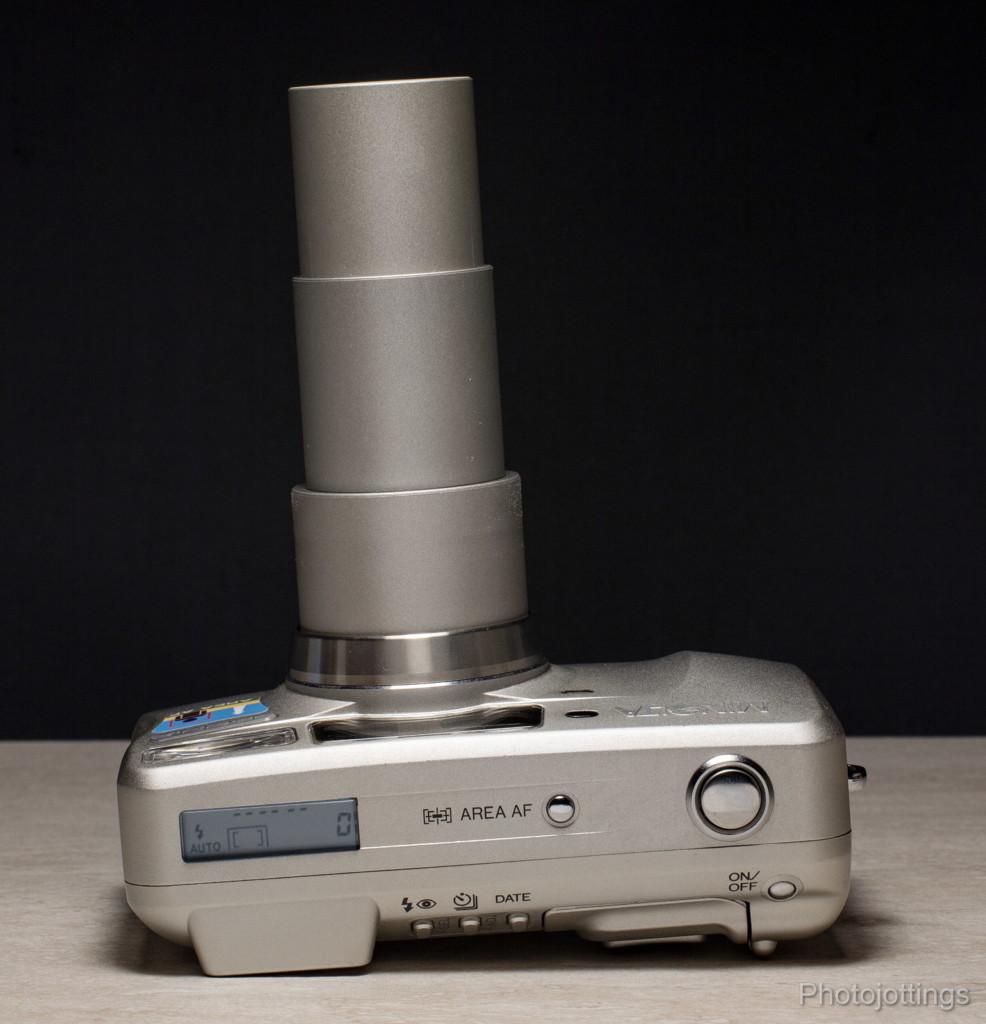
Here the lens is extended to 160mm. The camera won’t stay like this too long, and will turn off after eight minutes of inactivity.
Along the top is a small LCD with a lot of info to show, just not all at once. A few settings that appear on the LDC: the frame count is on the right, the date goes where the — — — lines are, (in this case it is turned off), the auto focus mode is center left, and flash info on the left.
The round middle button is for selecting the AF modes, which shows up on the LCD. The big chrome button on the right is the shutter.

The Minolta Freedom Zoom 160 is almost as small as the Olympus XA, but the Olympus doesn’t have a built in flash, and when added, it becomes noticeably larger than the Minolta.
Here are some test images scanned on a Nikon Super Coolscan 9000 ED. All are 3000 pixels wide; there is no additional resolution from scanning at a higher sample rate. Kodak Ultra Max 400 film used. Click for larger images.
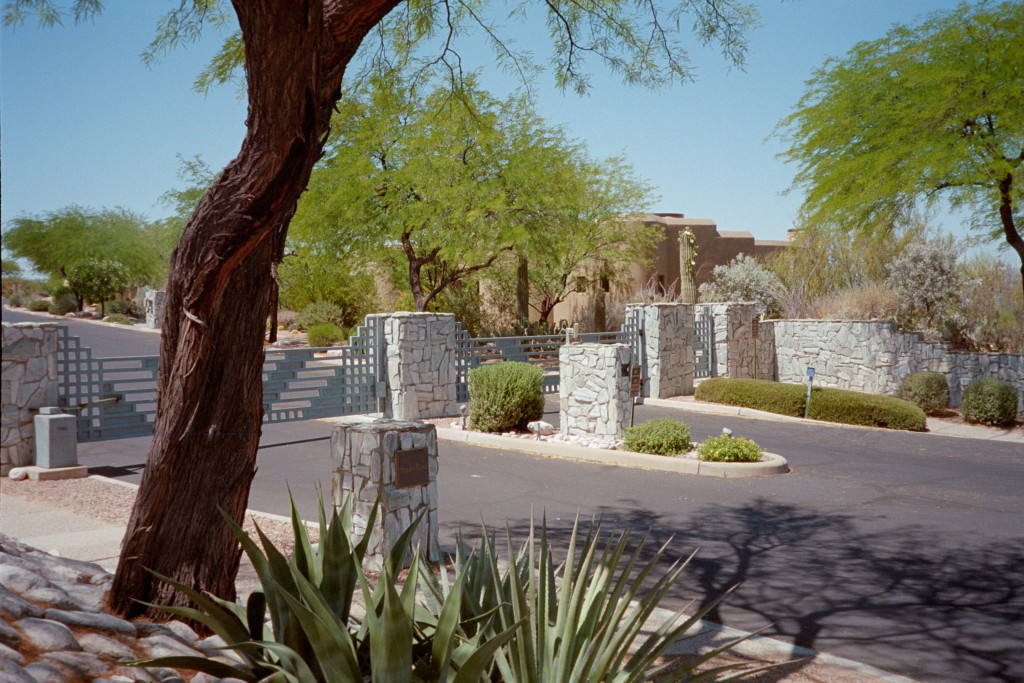
Entrance to detention center; 37.5mm. Some softness along the left side; very good center sharpness.

Close focus at the wide end. I’m not sure what aperture it chose for this shot, but the depth of field at close focus is pretty expansive.
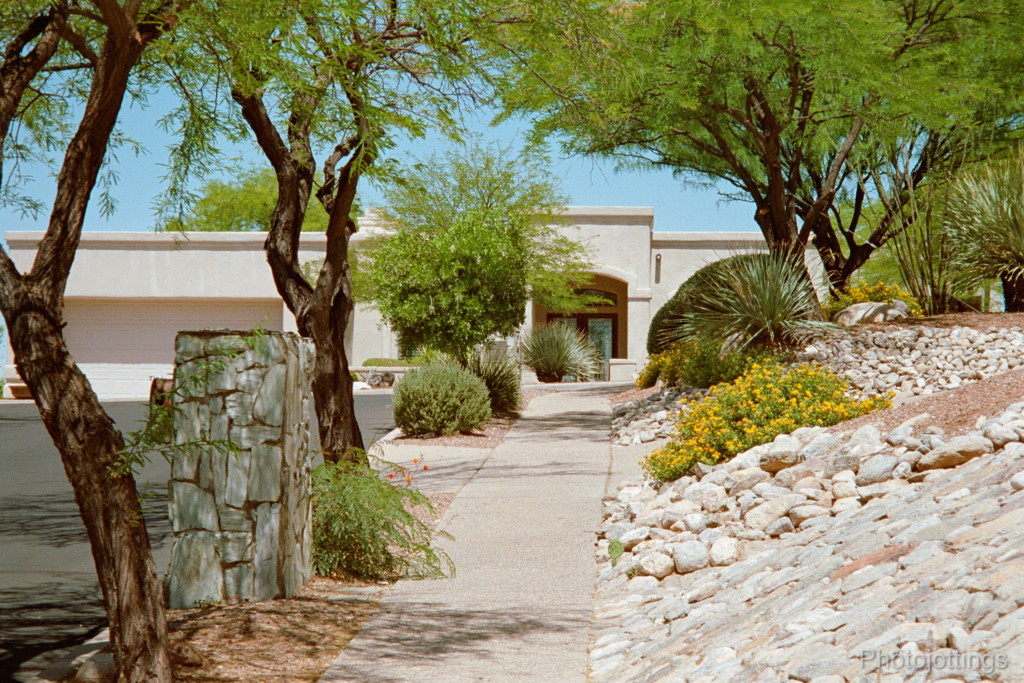
Taken at about 85mm, focused about half way to house.
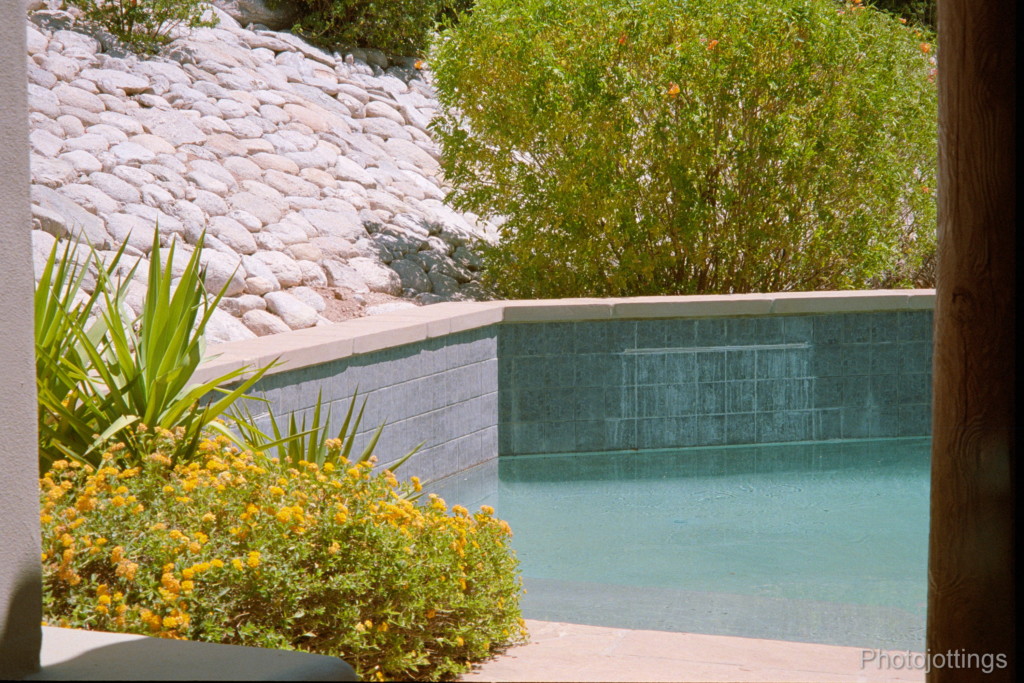
All the way out to 160mm. Notice the objects along the sides, I could not see them in the viewfinder.
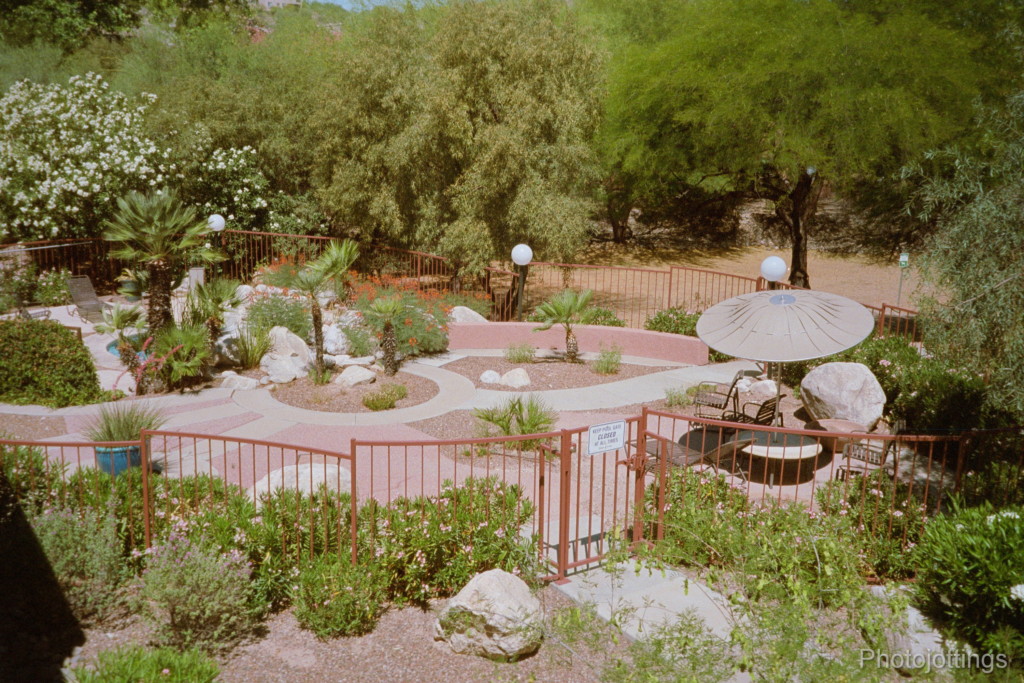
Wide angle shot. Nice detail in the central area, but softens as you go out to the sides.
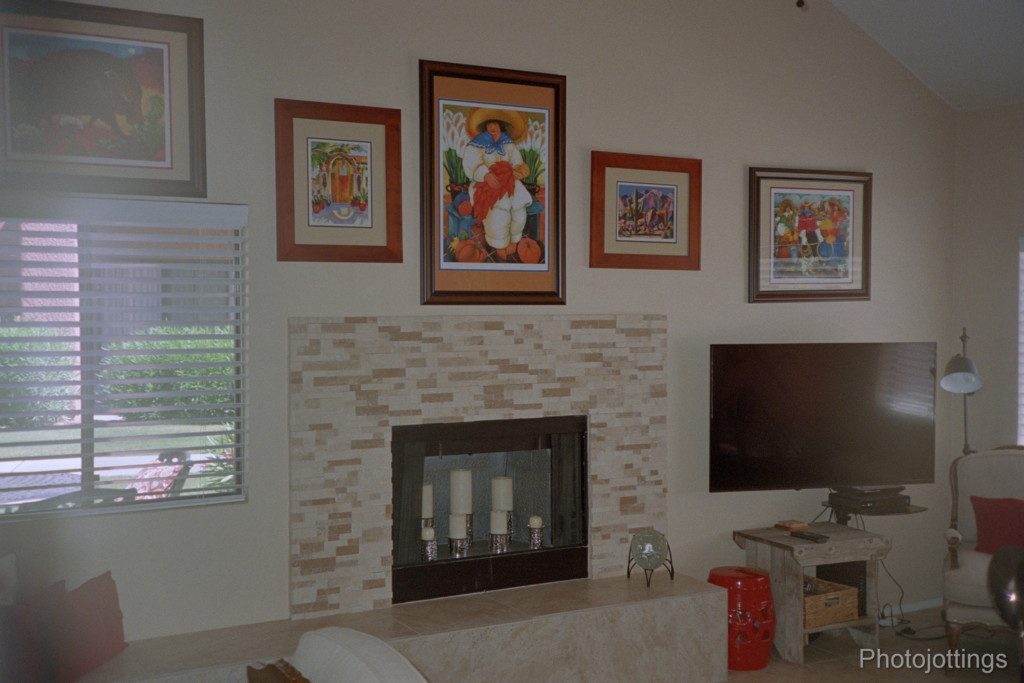
Interior shot using the flash. Blow out at left is caused by the flash hitting a white wall just out of view. Decent flash power for lighting up a room.
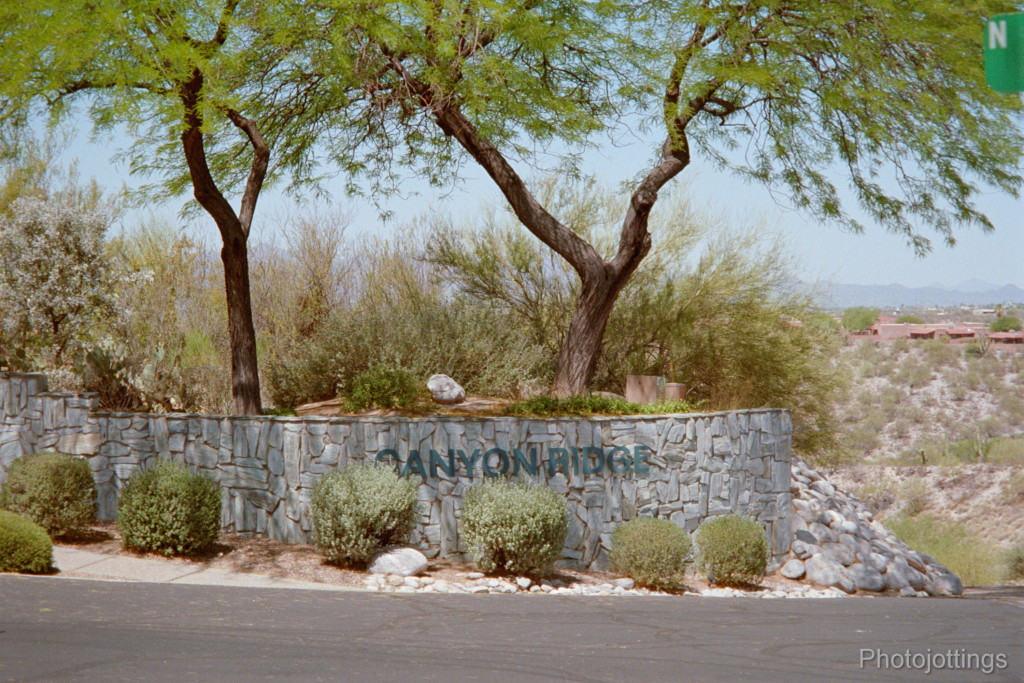
Canyon Ridge detention center at about 50mm. I couldn’t see the green street sign (upper right) in the viewfinder.
Conclusion.
The Minolta Freedom Zoom 160 Date is definitely a hidden gem in the compact film camera world. The AF is super quick and accurate; I had no missed focus shots at all, which is very surprising. The metering system is excellent, all frames where correctly exposed; (I used Kodak Ultra Max 400—not my favorite film, but I had a few extra rolls in the drawer…), and the handy exposure compensation setting was very useful in back-lit situations. Good news for this hidden gem; current prices are dirt cheap on ebay, around $15-$25
There isn’t much to dislike about the Minolta Freedom Zoom 160, it’s a super small and light-weight snap-shot camera, but I have to whine about something right? First, the starting focal length of 37.5 is a bit long for me, I’d prefer a little wider coverage starting around 28-32mm. The maximum aperture at the long end is a whopping F/12.4, so depth of field is pretty expansive, and getting background blur is tough unless you’re close to your subject either at the wide or telephoto end.
The lens on this little camera is good, but not great. As you probably have noticed by looking at the images above, the centers at wide angle are pretty sharp, but contrast and resolution fall off gradually as you near the sides. At longer focal lengths, a lack of contrast is more noticeable than a lack of resolution. With a compact camera in this price range and sporting a 4.3x zoom lens, Minolta had to make some compromises on quality. I think the goal here was to provide a lens that was acceptably sharp in the centers for portraits and flowers for example, and use the long reach of the telephoto as a marketing gimmick.
Even though the lens is not super sharp, I really like this camera for those quick one-handed snaps shots; the exposures and focusing are about as close to perfect as you can get, and the built-in flash is great for people pictures. I’d much prefer this Minolta for quick snaps than the equally tiny Olympus XA, which lacks the flash and requires manual rangefinder focusing.
The Minolta Freedom 160 Zoom is a great compact camera for people that want to have fun taking snap shots, and just want bright and colorful prints to share with friends and family like we all did back in the film days, and even now I guess.
For better colors and shadows than what you see above, try film like Kodak Ektar, Portra, or even Fuji 400h. B&H, Amazon, eBay.
Please consider buying your goodies through my links, doing so helps support the site, thanks!